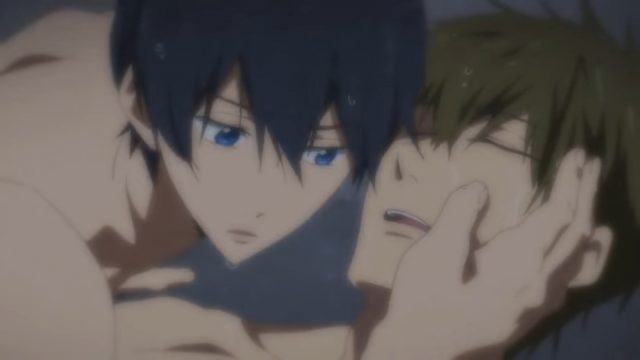First, there were fandoms. This has made a lot of people very angry and has been widely regarded as a bad etc. I used to hang out on the edges of fandom, and for all the variety of fandoms there are, there are actually a fairly simple set of expectations that unify them. To be in a fandom, all you need is to watch a show or movie and then generate ‘headcanons’ – a fact you personally invented or took on that isn’t part of the original story, of which ‘shipping’ – creating a relationship, romantic or otherwise, between two or more characters – is an extension. For example, if I decided that Captain Kirk’s favourite colour is blue, despite any lack of confirmation one way or the other, that would be a headcanon, and that would be enough to qualify me as someone in the Star Trek fandom. Headcanons don’t have to conform to ‘canon’ and often don’t; the expectation is that you use the original story as a jumping off point for creativity, even if it’s something as simple as inventing a fact.
Despite a reputation for being fucked up and weird, it’s an attitude I find charming when not taken too seriously – generally, fanart and fanfic are more interesting, but it is fun to watch people take a ‘what-if’ – ‘what if these characters were in a relationship’, ‘what if these characters worked in a coffee shop’ – and extrapolate the possibilities, especially since that’s just not how I naturally approach consuming art and storytelling. I prefer to take a story for what it is, and what it’s trying to be – my natural instinct, which I approach with increasing clarity of vision but have always had, is to explain and understand what I’m looking at. I watch a sitcom, I look at how the show’s sense of humour works; I watch a character study, I analyse the character’s behaviour and psychology. I mould myself to the story rather than moulding the story to me.
Then along came Free!, a slice-of-life anime from the studio Kyoto Animation. Kyoto’s claims to fame before Free! were The Melancholy Of Haruhi Suzumiya, a pastiche of just about every genre it could get its hands on as well as a wild experiment in storytelling via anti-storytelling techniques, and Lucky Star!, a slice of life about four nerdy girls that actively spat in the face of traditional storytelling. Free! is less audacious or silly than either of these shows; the premise is that three high school friends, Haruka, Nagisa, and Makoto, rebuild their school’s swimming team, and the story of the team bonding – as well as their rivalry with Haruka’s ex-friend Rin – is one that develops realistically and in a fairly traditionally dramatic fashion.
There are two things that make the show different. Firstly, Kyoto Animation bring an intense amount of detail into every work they do – Haruhi Suzumiya is, as well as a fantasy-scifi-time-travel-slice-of-life-antistory story, an extremely and unnecessarily detailed recreation of the city of Osaka – and this is no exception. Normally, when people say ‘realism’, they mean ‘blood, tits, grey, death’; this is realistic in the sense that what happens in it is drawn from the real world, barely heightened for story effect. There are real-world details like how each character’s body type and swimming costume reflects their style of swimming; aside from big spectacular setpieces that clearly symbolise the character’s inner world, the swimming scenes are as realistic as you can get and are contextualised by real-life Japanese high school swimming competition rules. It’s a Michael Mann level of detail in an otherwise extremely unMannly story.
Secondly, the subtext and drive of the story are implicitly aimed at shippers. Don’t get me wrong, this is a story that can be fully enjoyed as a straightforward upbeat drama about four boys who develop a friendship, but it feels crafted for shippers. Aside from each boy fulfilling an archetype (Haruka and Makoto are, respectively, the Stoic Socially Incompetent Hyperskilled One and the Dad Friend, two extremely common archetypes in fanfiction), all the conversations and scenes and relationships between these boys are loaded with subtext; the most famous scene in the anime is when Mako expresses love to Haru in a way where, due to the subtleties of the Japanese language, it’s extremely ambiguous whether it’s romantic or not. This is just the most extreme moment of something present all through the show, a quiet invitation to imagine what any pairing of characters would be like as a romantic couple embedded in the action. Like any good romance, the story is made up of both the characters as individuals and the being they make together.
It’s easiest to explain this with Haruka. His personal journey throughout the first season of the show is his gradual coming to terms with the world outside his love of swimming – a kinder, though in some ways less forgiving spin on the ‘asshole genius’ story, forcing Haruka to see value in things he otherwise has little interest in. Next to this are his two childhood friends – Makoto, kindhearted, sensitive; Rin, brash, explosive. Both pull Haru out of his comfort zone, partially due to their personalities, partially because he sincerely does love them both. Even without a vivid imagination reimagining the context of lines like “I’ll show you a sight you’ve never seen before!”, these relationships are sweet, and filled with glances and tenderness and unspoken words.
I recommend this story as a cute, low-key drama. The story of the development of the Iwatobi Swim Club is a charmingly simple take on the ‘found family’ concept; Haruka, Makoto, Nagisa, Rei, and Rin’s stories all feel important even when they don’t risk bringing their own world down upon their heads. I also recommend it as a peek through the eyes of shippers; even if you wouldn’t want to live there, it’s a nice place to visit.

